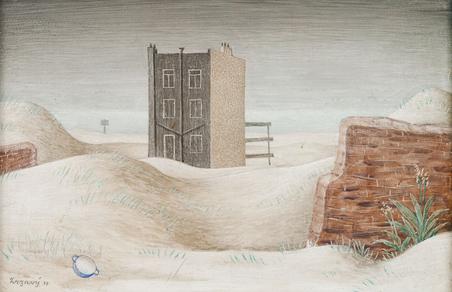Lot #96

Jan Zrzavý (1890–1977)
A House in the Dunes
Estimate: 3,000,000 CZK - 5,000,000 CZK
Starting price: 2,800,000 CZK
3,400,000 CZK
This view of the Brittany coast is a high-quality example of Jan Zrzavý’s most valued work from the 1930s. The painter discovered Brittany in the mid-1920s and found a landscape that became an endless source of inspiration for him for many years. The land of Celtic culture and untouched nature attracted him mainly for its rocks and sea. Villages with stone houses surrounded by stone ramparts, harbours and stone embankments facing the wild elements, sea dunes and waves formed the ideal landscape where he found a spiritual home. He regularly travelled mainly to the westernmost coast to the towns of Camaret-sur-Mer, Locronan, and Kermeur and the deserted islands of Île-de-Sein and the Île-de-Bréhat. In 1934, Zrzavý met Giorgio de Chirico, who accepted his invitation to Prague to participate in an exhibition at Umělecká beseda. Chirico highly appreciated Zrzavý’s work; he was particularly excited by the choice of colours and the interpretation of the absolute solitude of the human soul and nature. The presented painting was executed in the final period of the artist’s interest in Brittany because after returning to Czechoslovakia at the beginning of the Second World War, he turned to the subject matter of the Bohemian countryside. The mysterious scene of an abandoned two-story house resisting moving dunes, with a forgotten saucepan in the foreground, makes the painting one of the most impressive works of this period. The painting was presented at the artist’s exhibition in Umělecká beseda (Jan Zrzavý: New paintings and drawings, Umělecká beseda, Aleš Hall, Prague, 5–23 December 1937, cat. No. 3). The work comes from a high-quality and unique post-revolution collection. Assessed during consultations by prof. J. Zemina and PhDr. R. Michalová, Ph.D. The expertise of PhDr. K. Srp is attached.



